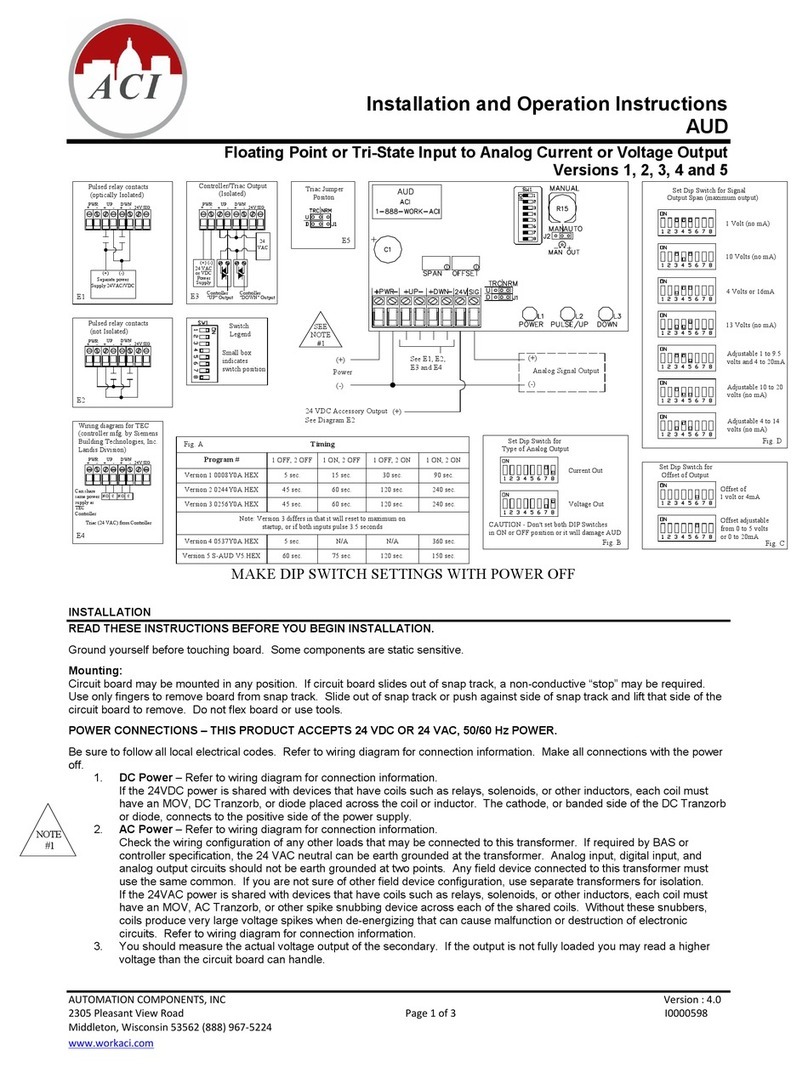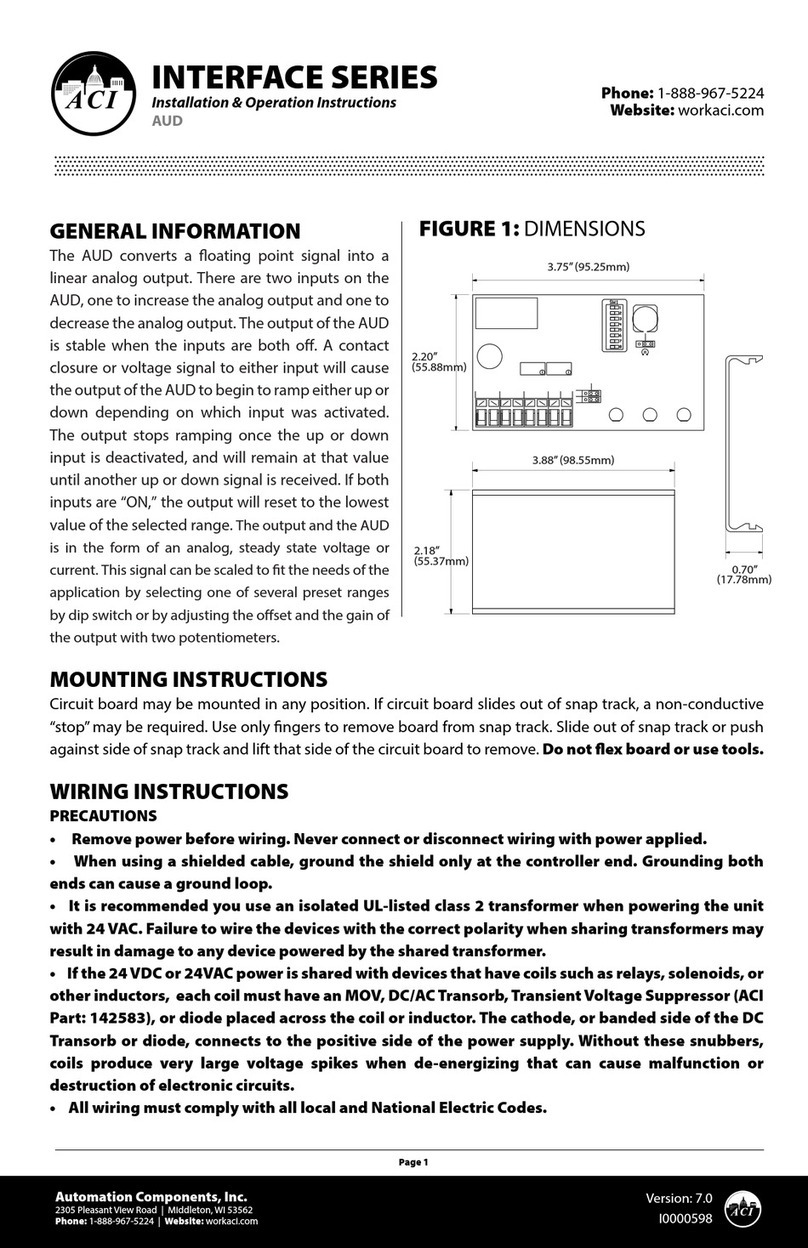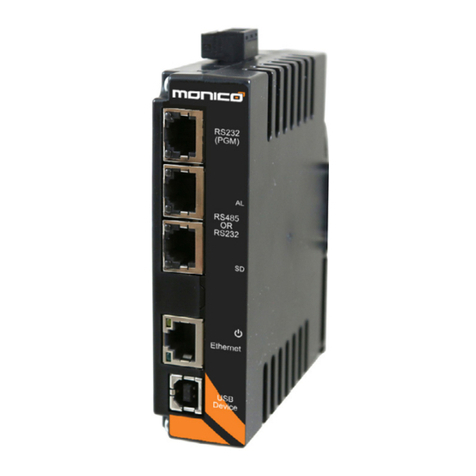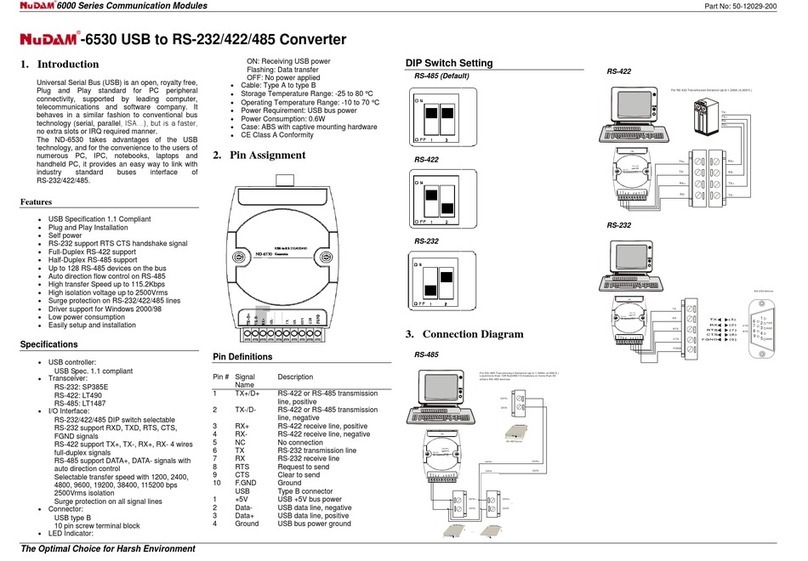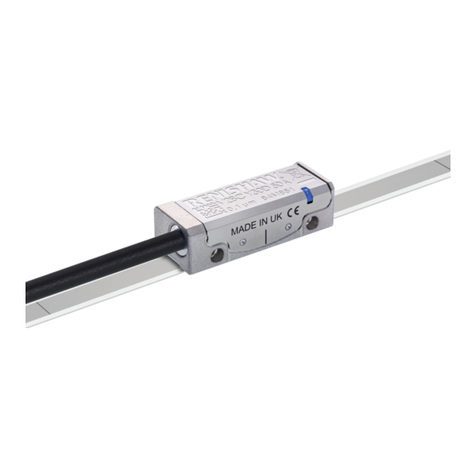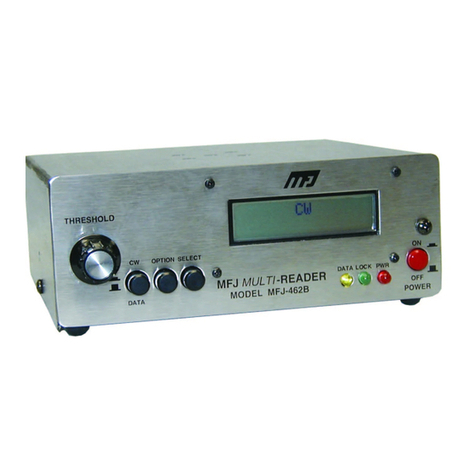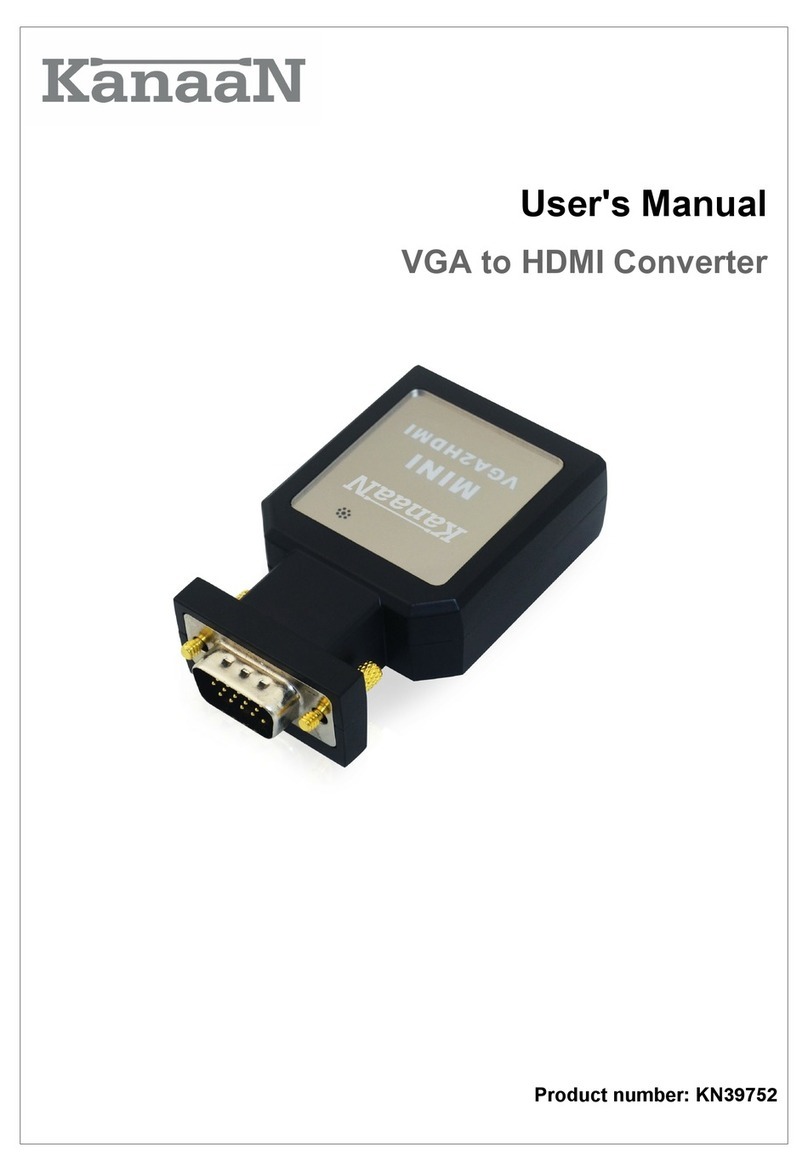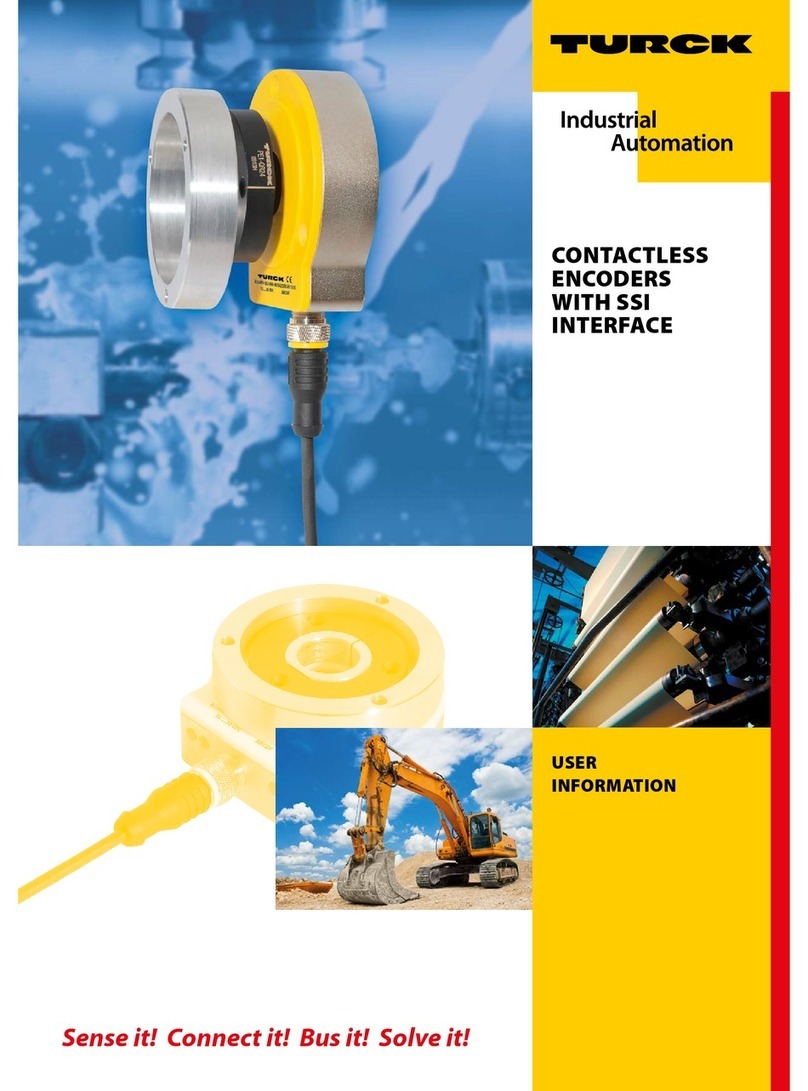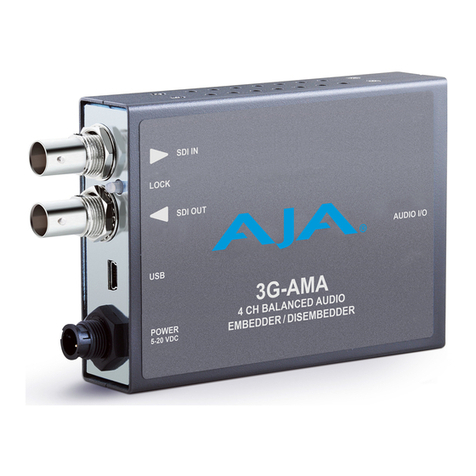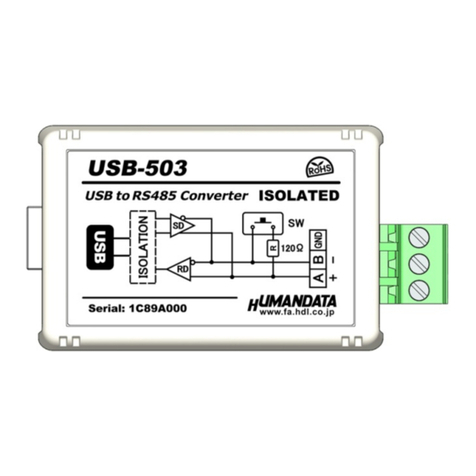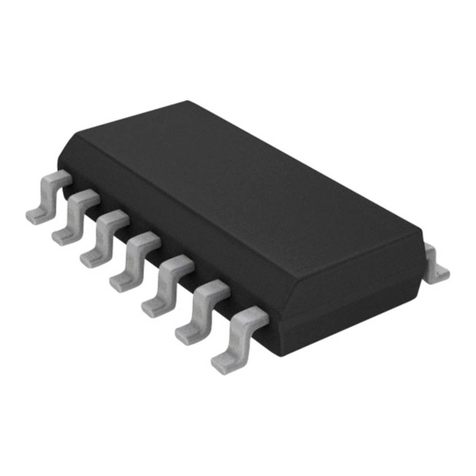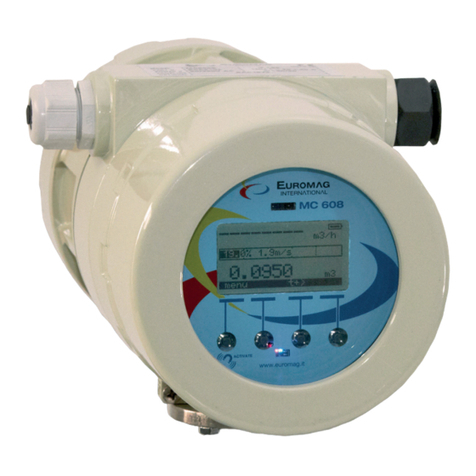aci ACCESS series Installation instructions

Automation Components, Inc.
2305 Pleasant View Road | Middleton, WI 53562
Phone: 1-888-967-5224 | Website: workaci.com
Page 1
Version: 4.0
I0000182
FIGURE 1: DIMENSIONS
INTERFACE SERIES
Installation & Operation Instructions
EPW
Phone: 1-888-967-5224
Website: workaci.com
GENERAL INFORMATION
The EPW converts a pulse or digital PWM signal
into a proportional pneumatic signal ranging from
0 to 20 psig. The pneumatic output is proportional
to the signal input, either direct or reverse acting,
and features a manual override potentiometer to
vary the pneumatic output. The EPW oers four
jumper selectable input timing ranges (see
ordering grid below). Output pressure ranges are
jumper shunt selectable for 0-10, 0-15 and 0-20
psig, and adjustable in all ranges. A 0-5 VDC
feedback signal indicating the resultant branch line
pressure is also provided. This signal varies linearly
with the branch pressure range selected. The EPW
is a constant bleed interface with branch exhaust
responce time determinded by the bleed orice
size and pressure dierentials. If power fails to the
EPW, it will continure to bleed through the bleed
orice until branch pressure is zero psig.
MOUNTING INSTRUCTIONS
Circuit board may be mounted in any position. If
circuit board slides out of snap track, a
non-conductive “stop” may be required. Use only
ngers to remove board from snap track. Slide
out of snap track or push against side of snap
track and lift that side of the circuit board to
remove. Do not flex board or use tools.
WIRING INSTRUCTIONS
PRECAUTIONS
• Remove power before wiring. Never
connect or disconnect wiring with power
applied.
• When using a shielded cable, ground the
shield only at the controller end. Grounding
both ends can cause a ground loop.
• It is recommended you use an isolated
UL-listed class 2 transformer when powering
the unit with 24 VAC. Failure to wire the
devices with the correct polarity when
sharing transformers may result in damage
to any device powered by the shared
transformer.
• If the 24 VDC or 24VAC power is shared with
devices that have coils such as relays,
solenoids, or other inductors, each coil must
have an MOV, DC/AC Transorb, Transient
Voltage Suppressor (ACI Part: 142583), or
diode placed across the coil or inductor. The
4.00” (101.60mm)
3.25”
(82.55mm)
EPW
0.70”
(17.78mm)
3.25” (82.55mm)
2.70”
(68.58mm)
EPW With Gauge
3.74” (94.92mm)
4.00”
(101.60mm)
2.95” (74.93mm)
Ø1.64”
(41.66mm)
WIRING (CONTINUED)
cathode, or banded side of the DC Transorb or diode, connects to the positive side of the power
supply. Without these snubbers, coils produce very large voltage spikes when de-energizing
that can cause malfunction or destruction of electronic circuits.
• All wiring must comply with all local and National Electric Codes.

FIGURE 2: WIRING
Automation Components, Inc.
2305 Pleasant View Road | Middleton, WI 53562
Phone: 1-888-967-5224 | Website: workaci.com
Page 2
Version: 4.0
I0000182
GENERAL INFORMATION
The EPW converts a pulse or digital PWM signal
into a proportional pneumatic signal ranging from
0 to 20 psig. The pneumatic output is proportional
to the signal input, either direct or reverse acting,
and features a manual override potentiometer to
vary the pneumatic output. The EPW oers four
jumper selectable input timing ranges (see
ordering grid below). Output pressure ranges are
jumper shunt selectable for 0-10, 0-15 and 0-20
psig, and adjustable in all ranges. A 0-5 VDC
feedback signal indicating the resultant branch line
pressure is also provided. This signal varies linearly
with the branch pressure range selected. The EPW
is a constant bleed interface with branch exhaust
responce time determinded by the bleed orice
size and pressure dierentials. If power fails to the
EPW, it will continure to bleed through the bleed
orice until branch pressure is zero psig.
MOUNTING INSTRUCTIONS
Circuit board may be mounted in any position. If
circuit board slides out of snap track, a
non-conductive “stop” may be required. Use only
ngers to remove board from snap track. Slide
out of snap track or push against side of snap
track and lift that side of the circuit board to
remove. Do not flex board or use tools.
WIRING INSTRUCTIONS
PRECAUTIONS
• Remove power before wiring. Never
connect or disconnect wiring with power
applied.
• When using a shielded cable, ground the
shield only at the controller end. Grounding
both ends can cause a ground loop.
• It is recommended you use an isolated
UL-listed class 2 transformer when powering
the unit with 24 VAC. Failure to wire the
devices with the correct polarity when
sharing transformers may result in damage
to any device powered by the shared
transformer.
• If the 24 VDC or 24VAC power is shared with
devices that have coils such as relays,
solenoids, or other inductors, each coil must
have an MOV, DC/AC Transorb, Transient
Voltage Suppressor (ACI Part: 142583), or
diode placed across the coil or inductor. The
WIRING (CONTINUED)
cathode, or banded side of the DC Transorb or diode, connects to the positive side of the power
supply. Without these snubbers, coils produce very large voltage spikes when de-energizing
that can cause malfunction or destruction of electronic circuits.
• All wiring must comply with all local and National Electric Codes.
Factory set - do not adjust
GAIN Potentiometer
Set for maximum
desired pressure with
maximum input signal
Version 4 (R.A.) Set for
maximum desired pressure
with minimum input signal
Offset Potentiometer
Set for minimum desired
pressure with minimum
input signal Version 4(R.A.)
Set for minimum desired
pressure with maximum
input signal
PWR C SC DN UP FB OV OV MAN
AUTO MAN
POWER
LED
OFFSET
SPAN
ZERO
STATUS LED
A
B
C
J2
A B J1
0
1
Output pressure range
selector factory set 0-15
Branch Line Output
Main Air Supply
Set Timing Range
- +
Manual Override Potentiometer
Manual Override Switch
Override Feedback (Dry Contact)
(+)
Branch Pressure
Feedback Signal
(-)
(+)
Power
24 VDC/VAC
(-)
Signal Common (-)
Pulse Signal (+)
UP
Down
MB
From Controller / Triac Out
+ 24 - SC DN
24 VAC
Power
Supply
24 VAC
Power
Supply
(+) (-)
or VDC
Not
Isolated
Switching
Common
From Controller / Triac Out
+ 24 - SC DN
24 VAC
Power
Supply
Not
Isolated
Switching
Hot
From Controller / Triac Out
+ 24 - SC DN
24 VAC
Power
Supply
Isolated

FIGURE 3: PNUEMATIC TUBING
INSTALLATION
FIGURE 4: PRESSURE OUTPUT JUMPER SETTINGS
Automation Components, Inc.
2305 Pleasant View Road | Middleton, WI 53562
Phone: 1-888-967-5224 | Website: workaci.com
Page 3
Version: 4.0
I0000182
WIRING INSTRUCTIONS (Continued)
The gauge port will accept a miniature 1/8”-27 FNPT back-ported pressure gauge to allow direct reading of
branch line pressure. The gauge should be sealed by Teon sealing tape, and should be tightened just
snug, using a backup wrench to hold the manifold.
Warranty does not include malfunction due to clogged valve. Main air port is ltered with the supplied 8
micron integral-in-barb lter. Periodically check the lter for contamination and ow reduction, and clean
with a brush or replace if needed (Part # PN004).
The surface between the manifold and pressure transducer is a pressure seal. DO NOT stress the circuit
board or allow the manifold to move. Hold the manifold in one hand while installing pneumatic tubing
onto the barbed ttings and use care when removing tubing to avoid damaging ttings or moving
manifold. Minimize stress between the circuit board and the manifold by holding the manifold in one hand
while installing pneumatic tubing onto the ttings, and use care when removing tubing to avoid
damaging ttings or moving manifold.
The bleed orice can be unscrewed with a ¼” hex nut driver for cleaning or inspection. Do not lose the
sealing gasket or insert anything into the precision orice. Clean by swabbing with a degreaser and
blowing clean air through the orice from the opposite direction. The color of the hex nut indicates orice
size: Brass = 0.007”.
This unit requires at least two cubic inches (minimum) of branch air line capacity (approx. 15’ of ¼” O.D.
polyethylene tubing) to operate without oscillation. Main air must be minimum of 2 psig above highest
desired branch output pressure.
Note: The input signal will not cause“wrap around”or start over if the upper range limit is exceeded.
CHECKOUT
SIGNAL INPUTS:
Version #1 & 4: See Figure 4 (p.4). Connect
the pulse input positive (+) to the down (DN)
terminal, and common to the signal common
(SC) terminal. Version #2: Solidyne PWM
signal and 0-10 second Duty Cycle Pulse of
Barber Colman ™, Robershaw ™. No pulse
within 10 seconds = minimum output. Pulse
equal or exceeding 10 seconds = maximum
output.
The EPW is factory calibrated at 0 psig
minimum and 15 psig maximum output. This
output can be re-calibrated to match the
pressure range of the actuator using the GAIN
and OFFSET potentiometer as follows: (Note:
The ZERO potentiometer is factory set. Do not
adjust.)
1.) Setting the input timing range: With power removed, place jumpers in the conguration that most
closely matches the timing range from the controller.
2.) Setting the output pressure range: Apply power. Choose a pressure range on the EPW that matches
or is just above maximum range of device being controlled. Example: 8-13 psi choose B (15 psi setting).
3.) Setting the maximum pressure: With all pneumatic and power connections made, place the Manual
override switch in the“MAN” position. Turn the override pot full clockwise.
4.) Setting the oset: Conrm no pulse has been sent, or remove power to reset output to minimum.
Place the Manual override switch in the “AUTO” position. Turn the “OFFSET” pot until the desired
minimum pressure is achieved.
5.) Calibration can also be made by sending the appropriate timing pulse and adjusting the“OFFSET”and
“SPAN” pots to the desired pressure output.
Without power, the power and the status LED will not be illuminated. Apply power and the“STATUS” LED
will blink slowly (twice per second), and the EPW will be at the lowest signal input state, or 0 psig. Apply
minimum and maximum input signals and measure the response. Version #1 Operation: The “STATUS”LED
will ash quickly when the EPW is receiving an input pulse, at the rate of the minimum resolution of the
selected pulse range, (i.e. 0.1 to 25.5 second range, the LED will ash 0.1 second on, 0.1 second o).
Exception: 0.59 to 2.93 sec. range – LED remains constant. Version #2 Operation: 0.023 – seconds – 1 ash,
the pulse. 0 -10 second Duty Cycle – 3 ashes, then pause. The input signal will NOT cause“wrap around”
or start over if the upper range limit is exceeded. Version #4 Operation: Same as Version #1 except output
is reverse acting.
The pneumatic output changes when the input pulse has been completed. Pressure output between the
minimum and maximum values will be linear, therefore
software algorithms should be easy to derive. The feedback
signal range on all selections is 0 to 5 VDC and is
proportional to the output pressure range (Factory
calibrated 0-15 psig).
The EPW is a constant bleed interface and utilizes a precision
orice to maintain a measured ow of air across the valve.
Manual override: Switch the AUTO/MAN toggle switch to the
MAN position. Turn the shaft on the MAN pot to increase or
decrease the pneumatic output. Return AUTO/MAN switch
to AUTO position when nished.
Override Terminals (OV)
When manual override switch is in manual position, contact
between terminals is closed. When manual override switch
is in auto position, contact between terminals is open.
WARRANTY
The EPW Series is covered by ACI’s Two (2) Year Limited Warranty,
which is located in the front of ACI’S SENSORS & TRANSMITTERS
CATALOG or can be found on ACI’s website: www.workaci.com.
W.E.E.E. DIRECTIVE
At the end of their useful life the packaging and product
should be disposed of via a suitable recycling centre. Do not
dispose of with household waste. Do not burn.
A
B
C
J2
A
B
C
J2
A
B
C
J2
0 to 15 psig
(Factory Setting)
0 to 10 psig 0 to 20 psig
Min Tubing Length:
15 ft [ 4.572 m]
Air Compressor

FIGURE 4: SIGNAL INPUTS
Automation Components, Inc.
2305 Pleasant View Road | Middleton, WI 53562
Phone: 1-888-967-5224 | Website: workaci.com
Page 4
Version: 4.0
I0000182
WIRING INSTRUCTIONS (Continued)
The gauge port will accept a miniature 1/8”-27 FNPT back-ported pressure gauge to allow direct reading of
branch line pressure. The gauge should be sealed by Teon sealing tape, and should be tightened just
snug, using a backup wrench to hold the manifold.
Warranty does not include malfunction due to clogged valve. Main air port is ltered with the supplied 8
micron integral-in-barb lter. Periodically check the lter for contamination and ow reduction, and clean
with a brush or replace if needed (Part # PN004).
The surface between the manifold and pressure transducer is a pressure seal. DO NOT stress the circuit
board or allow the manifold to move. Hold the manifold in one hand while installing pneumatic tubing
onto the barbed ttings and use care when removing tubing to avoid damaging ttings or moving
manifold. Minimize stress between the circuit board and the manifold by holding the manifold in one hand
while installing pneumatic tubing onto the ttings, and use care when removing tubing to avoid
damaging ttings or moving manifold.
The bleed orice can be unscrewed with a ¼” hex nut driver for cleaning or inspection. Do not lose the
sealing gasket or insert anything into the precision orice. Clean by swabbing with a degreaser and
blowing clean air through the orice from the opposite direction. The color of the hex nut indicates orice
size: Brass = 0.007”.
This unit requires at least two cubic inches (minimum) of branch air line capacity (approx. 15’ of ¼” O.D.
polyethylene tubing) to operate without oscillation. Main air must be minimum of 2 psig above highest
desired branch output pressure.
Note: The input signal will not cause“wrap around”or start over if the upper range limit is exceeded.
CHECKOUT
SIGNAL INPUTS:
Version #1 & 4: See Figure 4 (p.4). Connect
the pulse input positive (+) to the down (DN)
terminal, and common to the signal common
(SC) terminal. Version #2: Solidyne PWM
signal and 0-10 second Duty Cycle Pulse of
Barber Colman ™, Robershaw ™. No pulse
within 10 seconds = minimum output. Pulse
equal or exceeding 10 seconds = maximum
output.
The EPW is factory calibrated at 0 psig
minimum and 15 psig maximum output. This
output can be re-calibrated to match the
pressure range of the actuator using the GAIN
and OFFSET potentiometer as follows: (Note:
The ZERO potentiometer is factory set. Do not
adjust.)
1.) Setting the input timing range: With power removed, place jumpers in the conguration that most
closely matches the timing range from the controller.
2.) Setting the output pressure range: Apply power. Choose a pressure range on the EPW that matches
or is just above maximum range of device being controlled. Example: 8-13 psi choose B (15 psi setting).
3.) Setting the maximum pressure: With all pneumatic and power connections made, place the Manual
override switch in the“MAN” position. Turn the override pot full clockwise.
4.) Setting the oset: Conrm no pulse has been sent, or remove power to reset output to minimum.
Place the Manual override switch in the “AUTO” position. Turn the “OFFSET” pot until the desired
minimum pressure is achieved.
5.) Calibration can also be made by sending the appropriate timing pulse and adjusting the“OFFSET”and
“SPAN” pots to the desired pressure output.
Without power, the power and the status LED will not be illuminated. Apply power and the“STATUS” LED
will blink slowly (twice per second), and the EPW will be at the lowest signal input state, or 0 psig. Apply
minimum and maximum input signals and measure the response. Version #1 Operation: The “STATUS”LED
will ash quickly when the EPW is receiving an input pulse, at the rate of the minimum resolution of the
selected pulse range, (i.e. 0.1 to 25.5 second range, the LED will ash 0.1 second on, 0.1 second o).
Exception: 0.59 to 2.93 sec. range – LED remains constant. Version #2 Operation: 0.023 – seconds – 1 ash,
the pulse. 0 -10 second Duty Cycle – 3 ashes, then pause. The input signal will NOT cause“wrap around”
or start over if the upper range limit is exceeded. Version #4 Operation: Same as Version #1 except output
is reverse acting.
The pneumatic output changes when the input pulse has been completed. Pressure output between the
minimum and maximum values will be linear, therefore
software algorithms should be easy to derive. The feedback
signal range on all selections is 0 to 5 VDC and is
proportional to the output pressure range (Factory
calibrated 0-15 psig).
The EPW is a constant bleed interface and utilizes a precision
orice to maintain a measured ow of air across the valve.
Manual override: Switch the AUTO/MAN toggle switch to the
MAN position. Turn the shaft on the MAN pot to increase or
decrease the pneumatic output. Return AUTO/MAN switch
to AUTO position when nished.
Override Terminals (OV)
When manual override switch is in manual position, contact
between terminals is closed. When manual override switch
is in auto position, contact between terminals is open.
WARRANTY
The EPW Series is covered by ACI’s Two (2) Year Limited Warranty,
which is located in the front of ACI’S SENSORS & TRANSMITTERS
CATALOG or can be found on ACI’s website: www.workaci.com.
W.E.E.E. DIRECTIVE
At the end of their useful life the packaging and product
should be disposed of via a suitable recycling centre. Do not
dispose of with household waste. Do not burn.
A B J1
0
1
0.1 - 10 sec.
0.1 - 25.5 sec.
0.02 - 5 sec.
0.59 - 2.93 sec.
Timing Ranges
Versions # 1 & 4
0011Y0F.HEX Ver. 1
0443Y0A.HEX Ver. 4
A B J1
0
1
0.23 - 6 sec.
Timing Ranges
Version # 2
0302YOB.HEX
Soldyne

PRODUCT SPECIFICATIONS
24 VAC (+/-10%), 50 or 60Hz, 24 VDC (+10%/- 5%)
50 mA, 150 mA on pressure excursions (standard) | 200 mA on pressure
excursions (fail-safe)
Relay Contact Closure, Transistor (solid state relay) or Triac
9-24 VAC or VDC @ 750 nominal
10 milliseconds minimum
EPW: 0.1-10s, 0.02-5s, 0.1-25s, 0.59-2.93s | EPWG: 0.1-10s, 0.02-5s, 0.1-25s,
0.59-2.93s | EPW Version 2: 0.023-6s or 0-10s Duty Cycle | EPWG Verison 2:
0.023-6s or 0-10s Duty Cycle | EPW Version 4: Same as version 1, reverse acting
| EPWG Version 4: Same as version 1, reverse acting | 255 Steps
MAN function = output can be varied | AUTO function = output is controlled
from input signal
N.O. in AUTO operation (Optional: N.O. in MAN operation)
0-5 VDC = Output Span
Field Calibration Possible: 0 to 20 psig (0-138 kPa) maximum
0-10 psig (0-68.95 kPa), 0-15 psig (0-103.43 kPa) or 0-20 psig (137.9 kPa)
Maximum 25 psig (172.38 kPa), minimum 20 psig (137.9 kPa)
2% full scale at room temperature (above 1 psig or 6.895 kPa)
3% full scale across operating temperature range (above 1 psig or 6.895 kPa)
Supply valves @ 20 psig (138 kPa) main/15 psig (103 kPa) out, 750 scim
Branch Line requires 2 in or 33.78 cm (min.). Branch line min. of 15 ft of 1/4”
O.D. poly tubing
Furnished with integral-in-barb 80-100 micron lter (Part # PN004)
Optional standard barb (PN002) with external 5 micron in-line lter (PN021)
90° Pluggable Screw Terminal Blocks
16 (1.31 mm) to 26 AWG (0.129 mm)
0.5 Nm (Minimum); 0.6 Nm (Maximum)
1/4" O.D. nominal (1/8” I.D.) polyethylene
Removeable brass ttings for Main & Branch in machined manifold, Plugged
1/8-27-FNPT gauge port
0-30psig (0-200 kPa)
35 to 120°F (1.7 to 48.9°C)
10 to 95% non-condensing
-20 to 150°F (-28.9 to 65.5°C)
NON-SPECIFIC INFORMATION
Supply Voltage:
Supply Current:
Input Pulse Source:
Input Pulse Trigger Level (@
Impedance):
Off Time Between Pulses:
Input Pulse Timing |
Resolution:
Manual/Auto Override Switch:
Manual/Auto Override
Feedback Output:
Feedback Output Signal Range:
Output Pressure Range:
Output Pressure Range-Jumper
Selectable:
Air Supply Pressure:
Output Pressure Accuracy:
Air Flow:
Filtering:
Connections:
Wire Size:
Terminal Block Torque Rating:
Connections | Pneumatic
Tubing Size-Type:
Pneumatic Fitting:
Gauge Pressure Range (Gauge
Models):
Operating Temperature Range:
Operating Humidity Range:
Storage Temperature:
Automation Components, Inc.
2305 Pleasant View Road | Middleton, WI 53562
Phone: 1-888-967-5224 | Website: workaci.com
Page 5
Version: 4.0
I0000182

NOTES
Page 6
Automation Components, Inc.
2305 Pleasant View Road | Middleton, WI 53562
Phone: 1-888-967-5224 | Website: workaci.com
Version: 4.0
I0000182

Page 7
NOTES
Automation Components, Inc.
2305 Pleasant View Road | Middleton, WI 53562
Phone: 1-888-967-5224 | Website: workaci.com
Version: 4.0
I0000182

Automation Components, Inc.
2305 Pleasant View Road
Middleton, WI 53562
Phone: 1-888-967-5224
Website: workaci.com
Page 8
Automation Components, Inc.
2305 Pleasant View Road | Middleton, WI 53562
Phone: 1-888-967-5224 | Website: workaci.com
Version: 4.0
I0000182
Other manuals for ACCESS series
16
This manual suits for next models
2
Table of contents
Other aci Media Converter manuals
